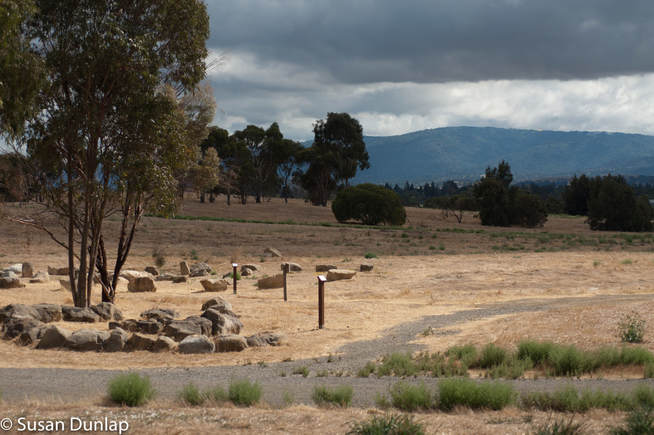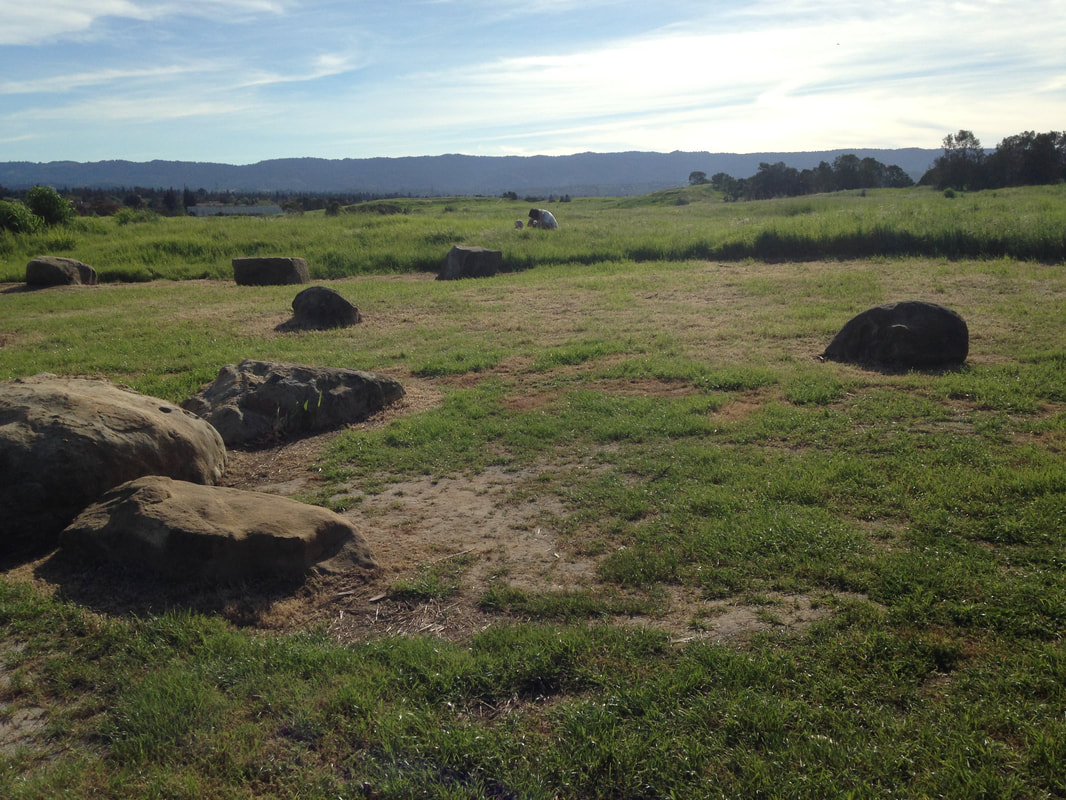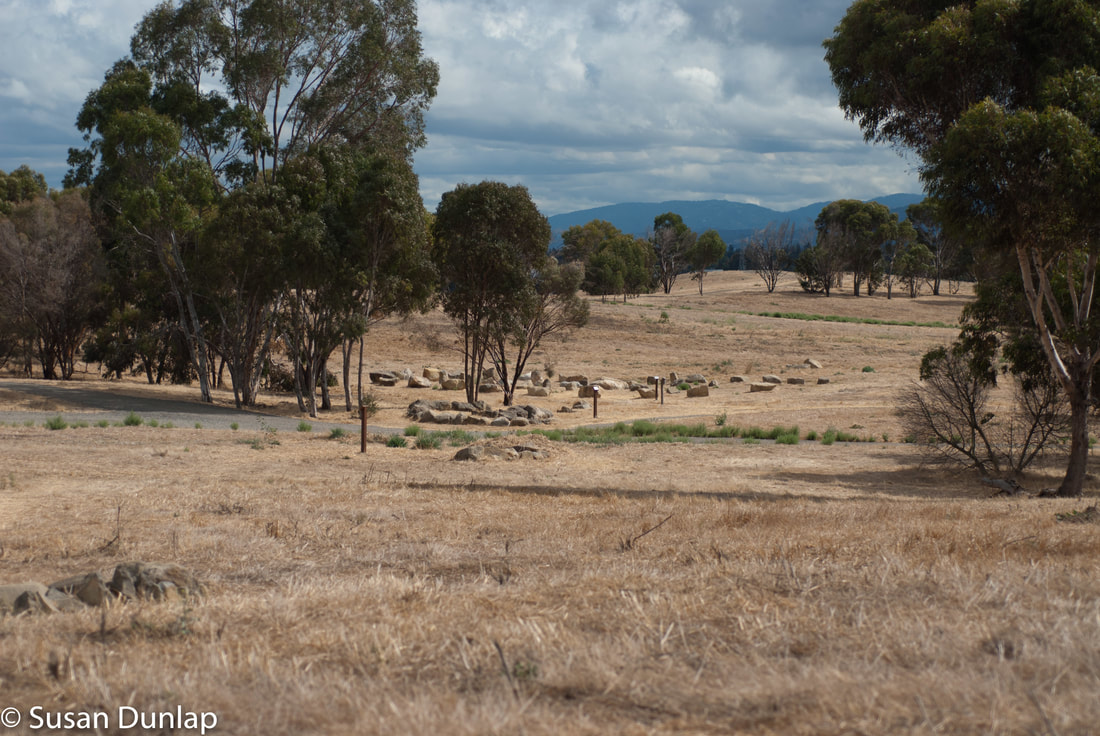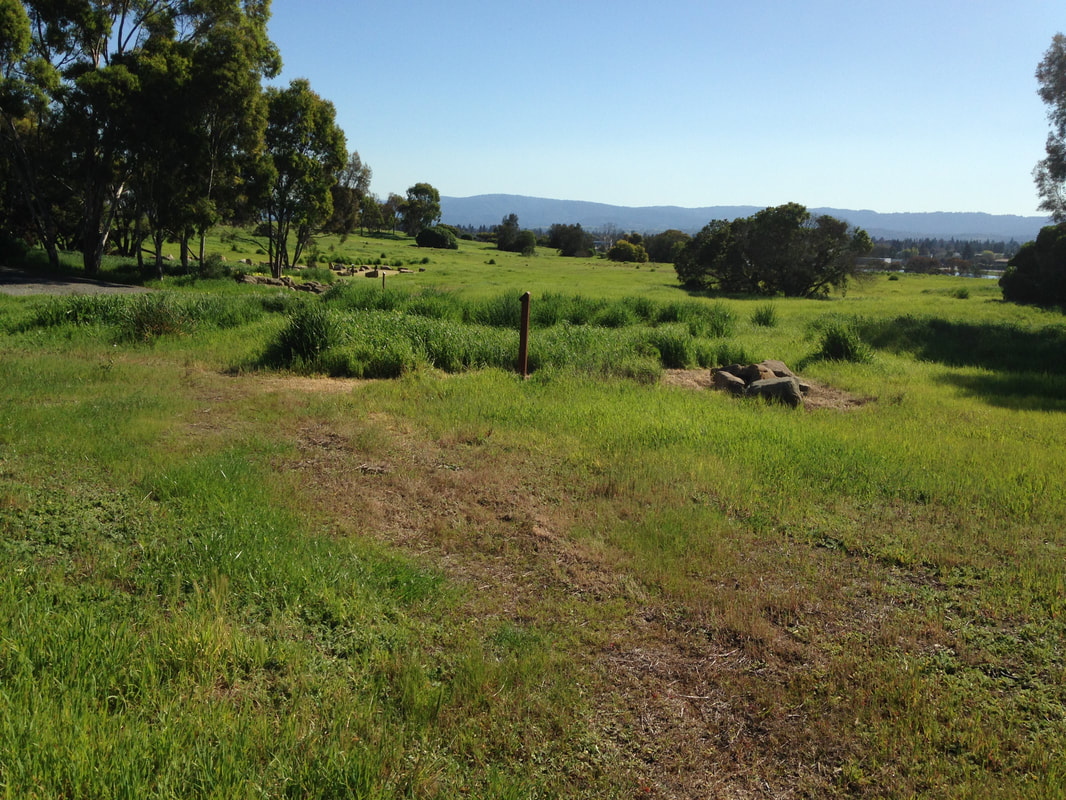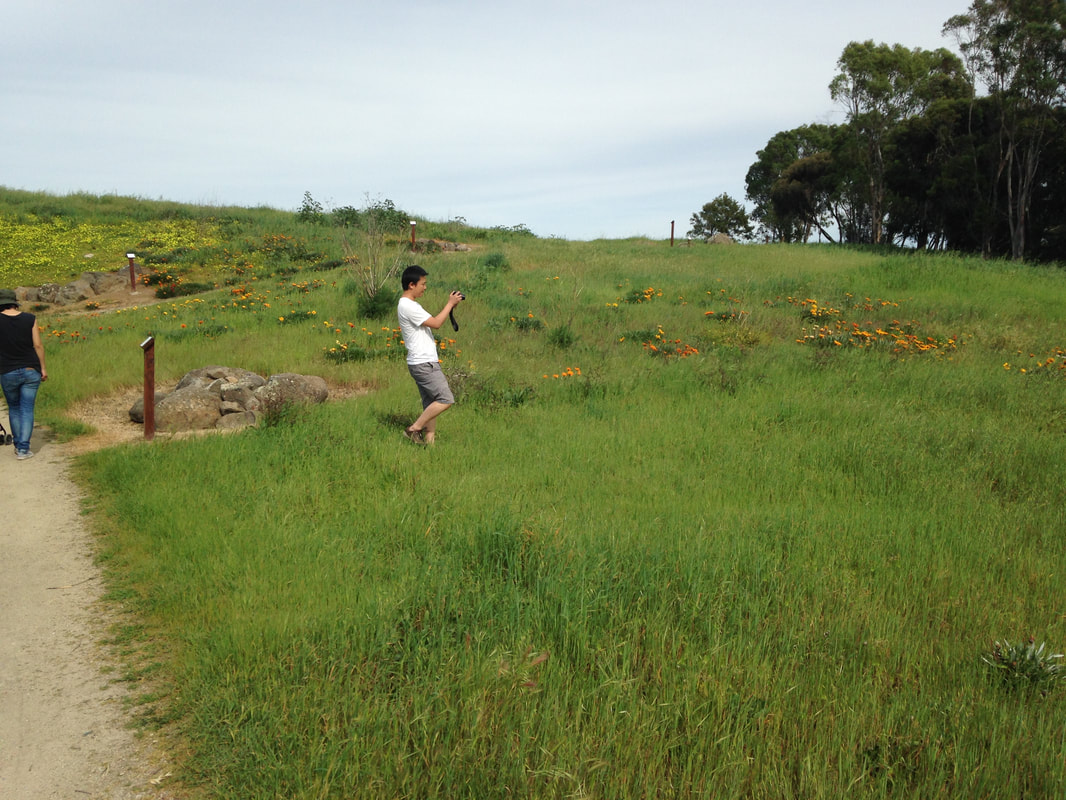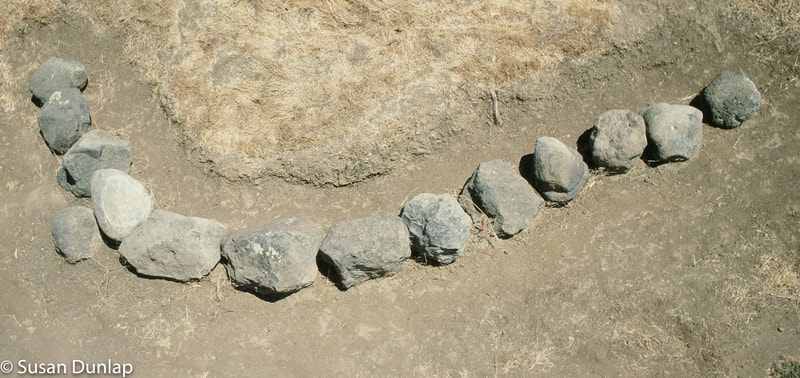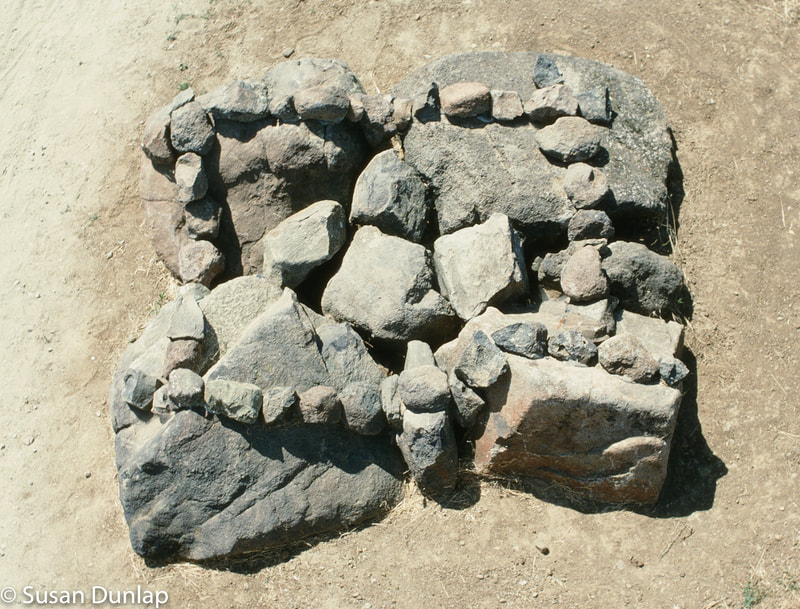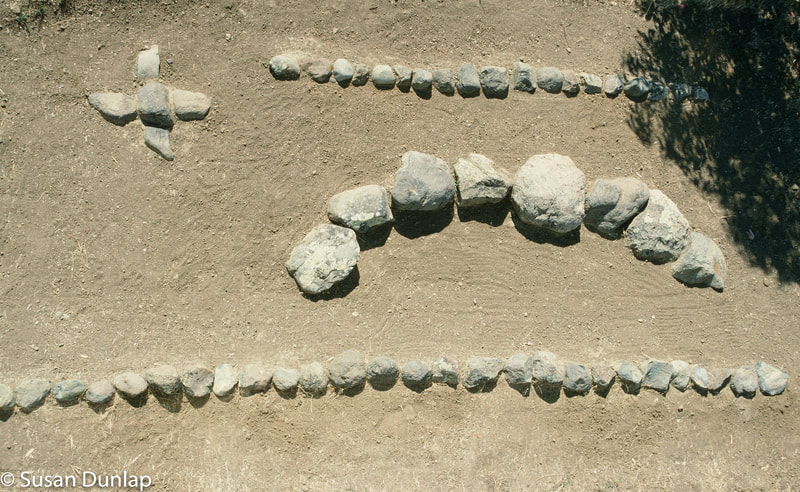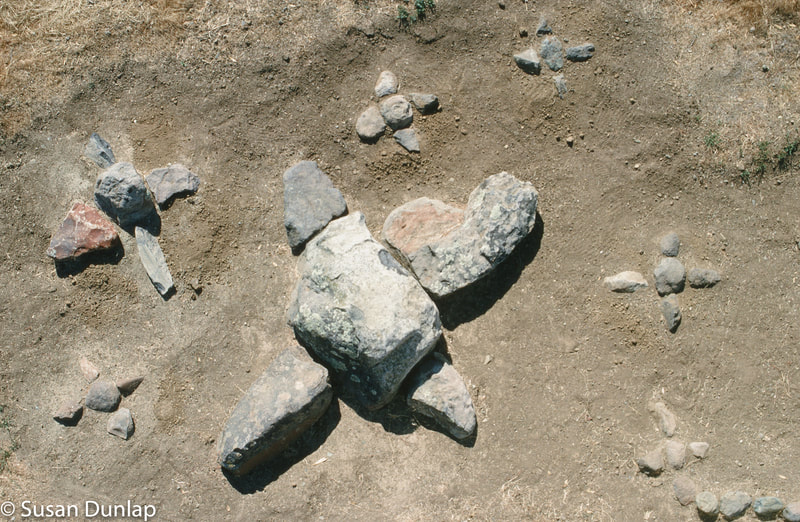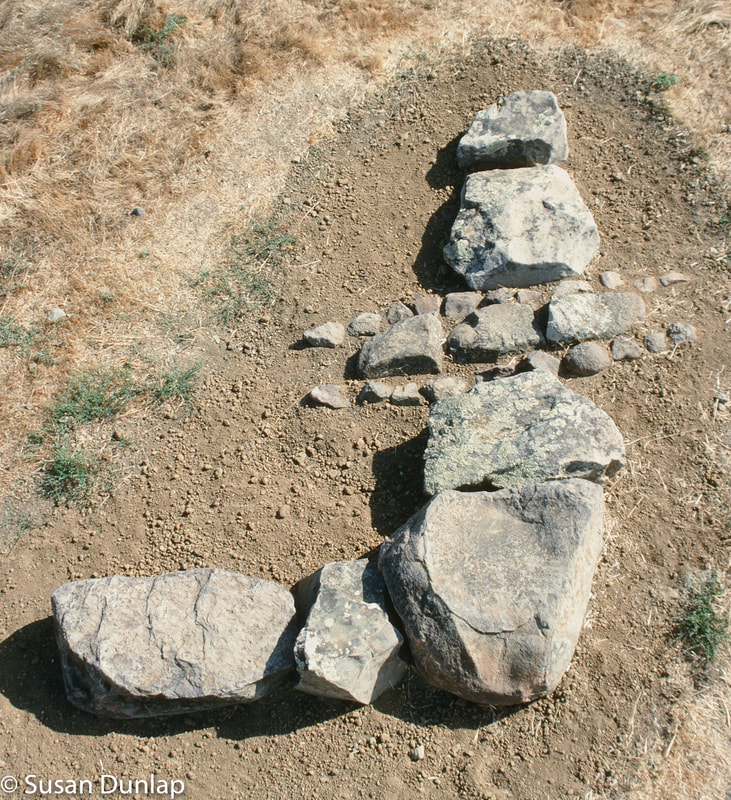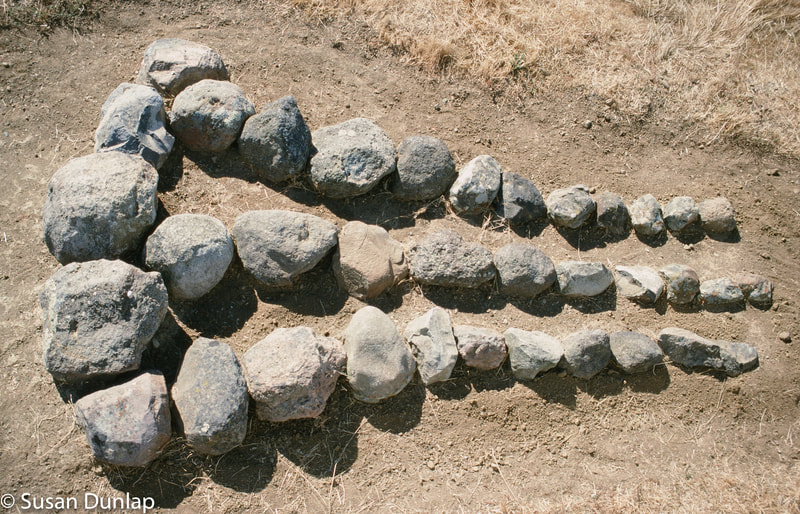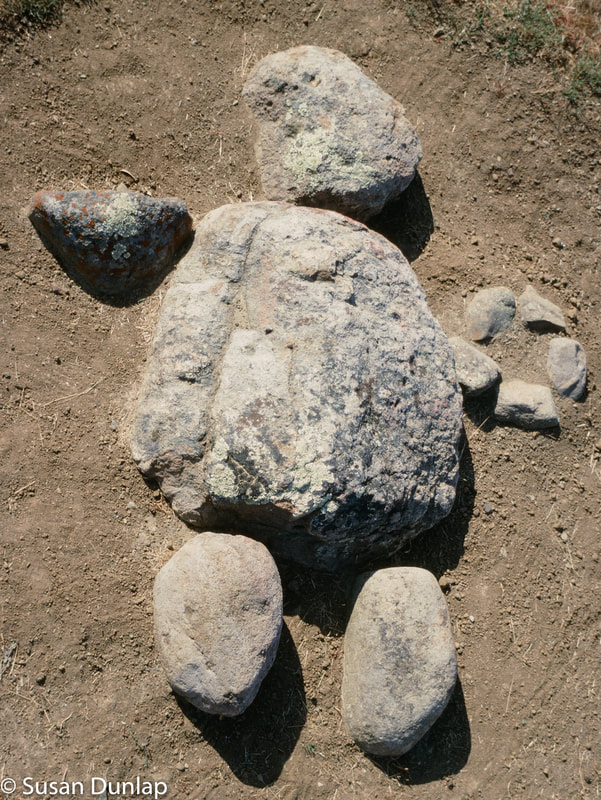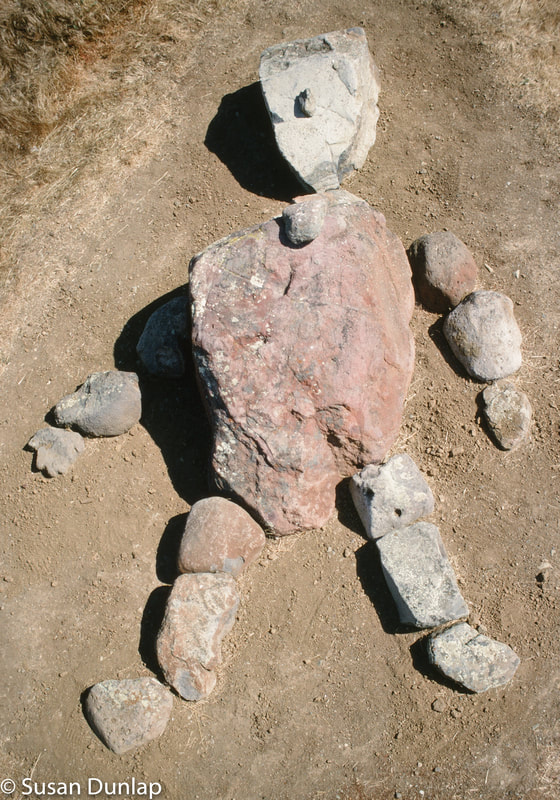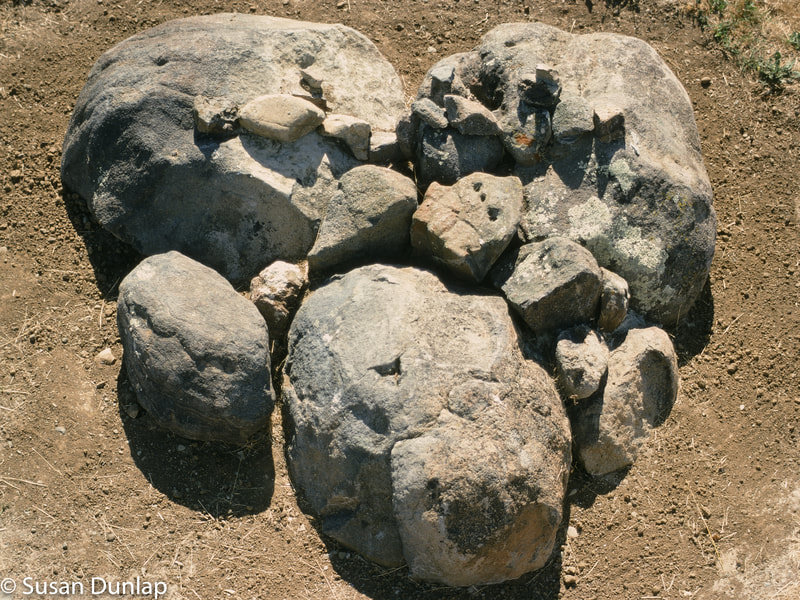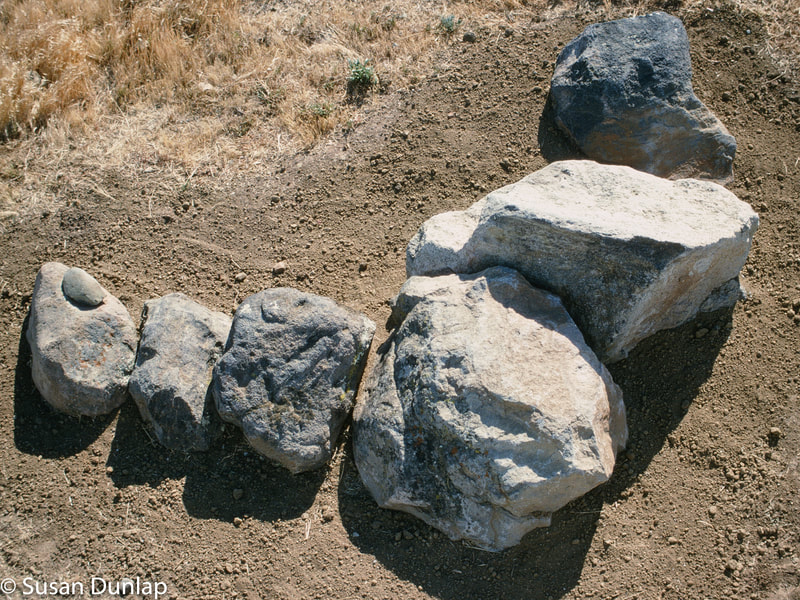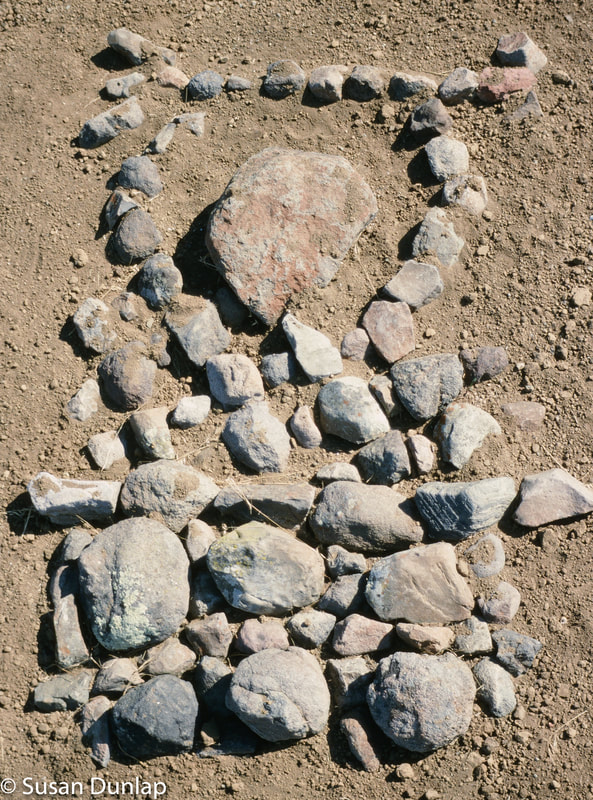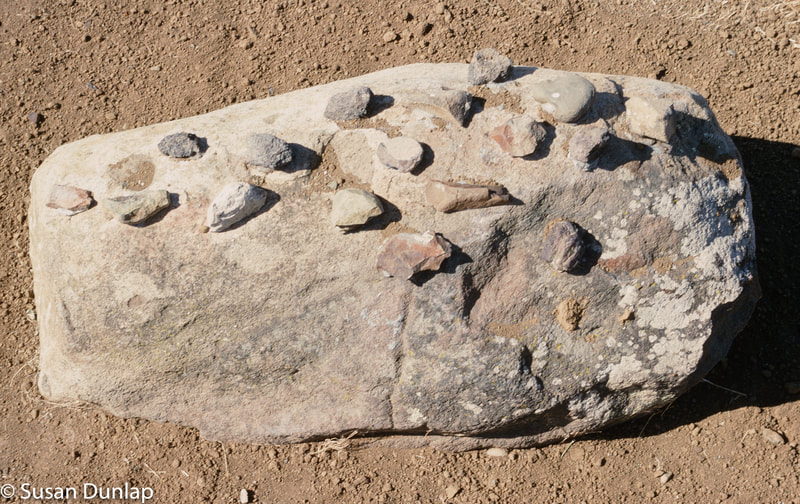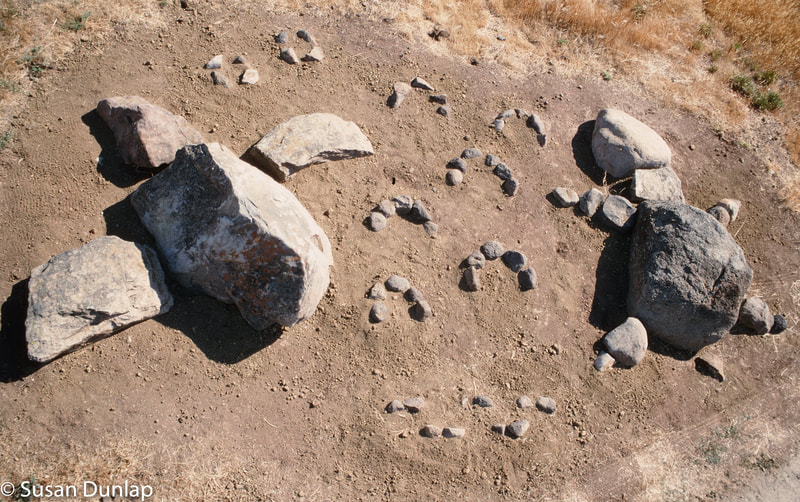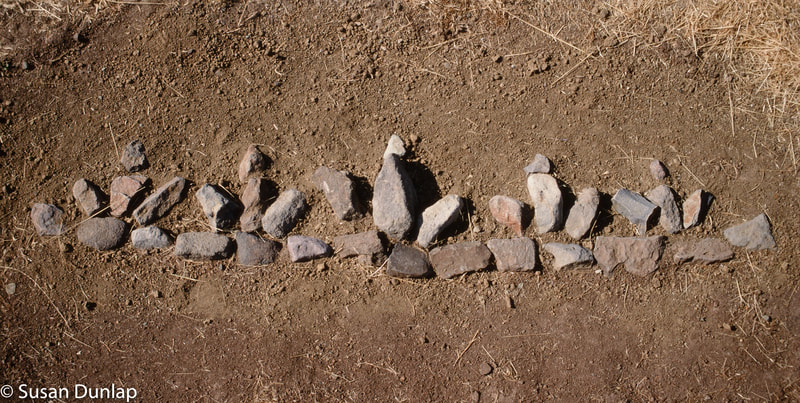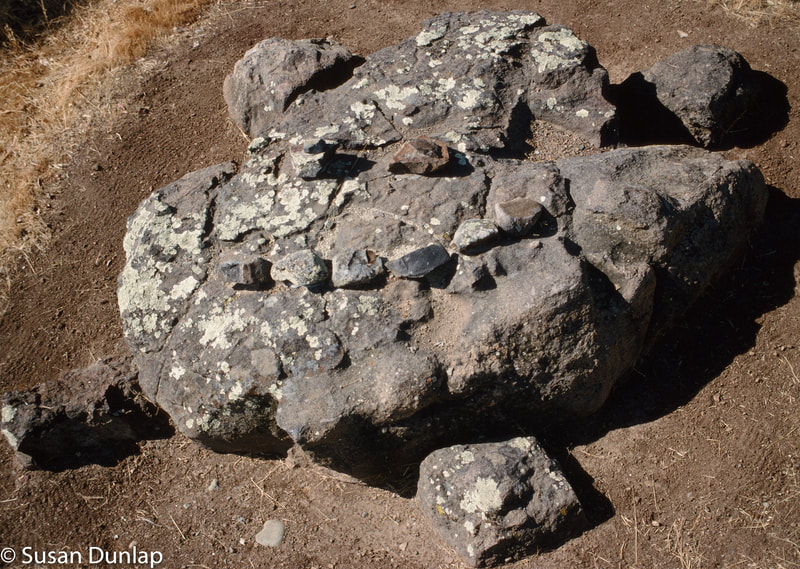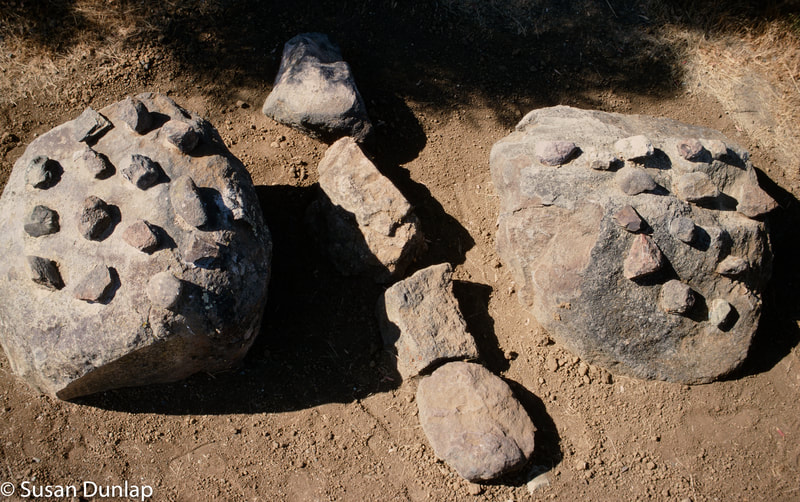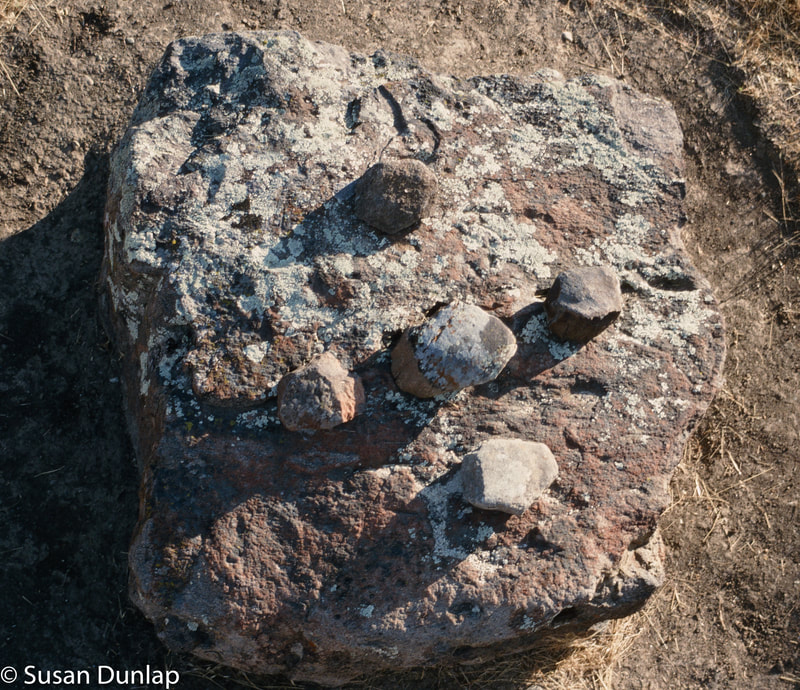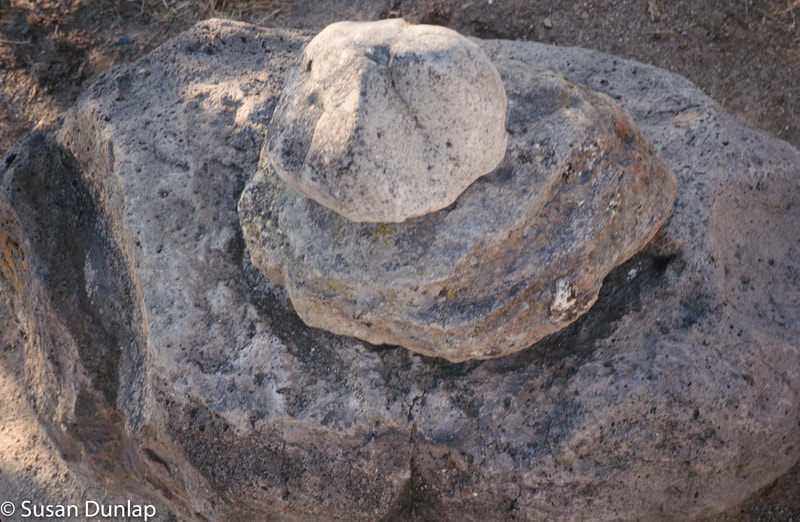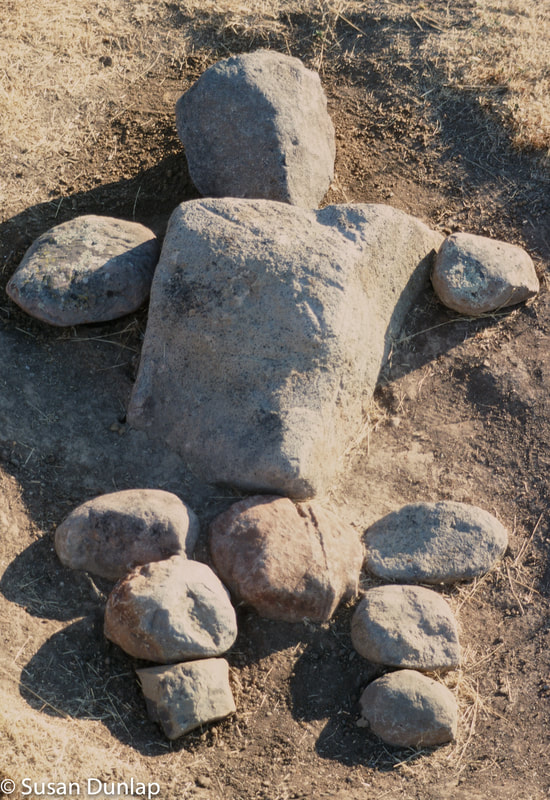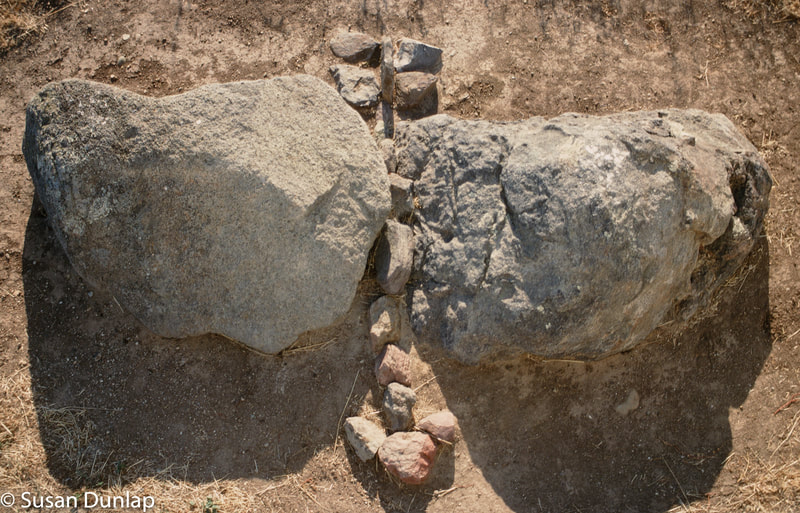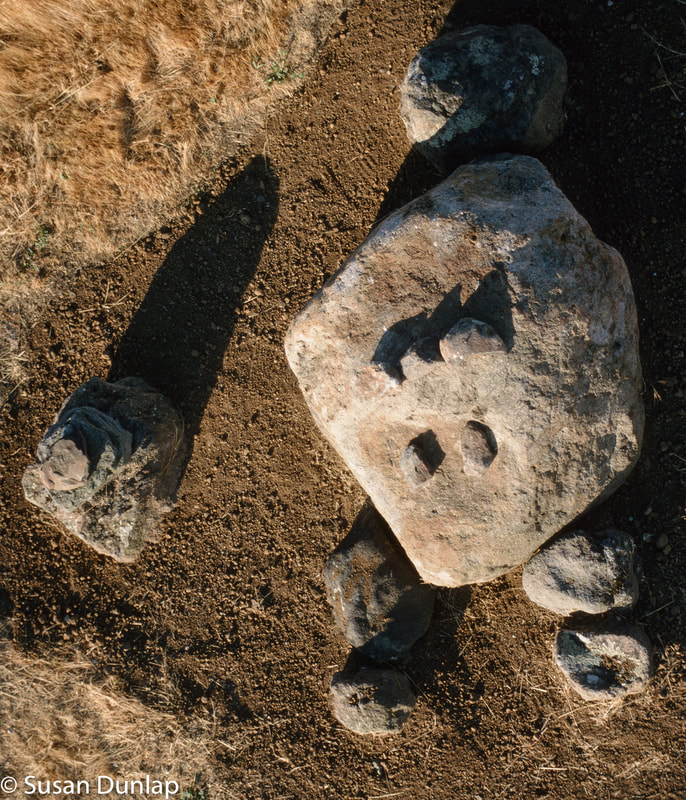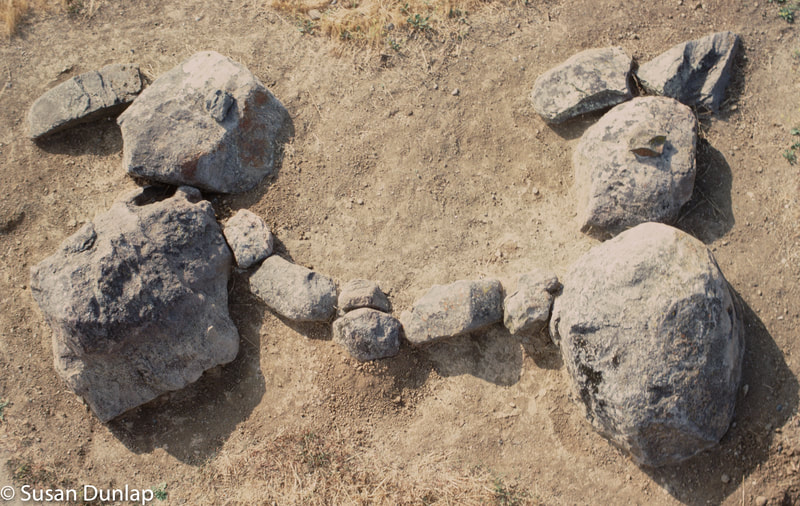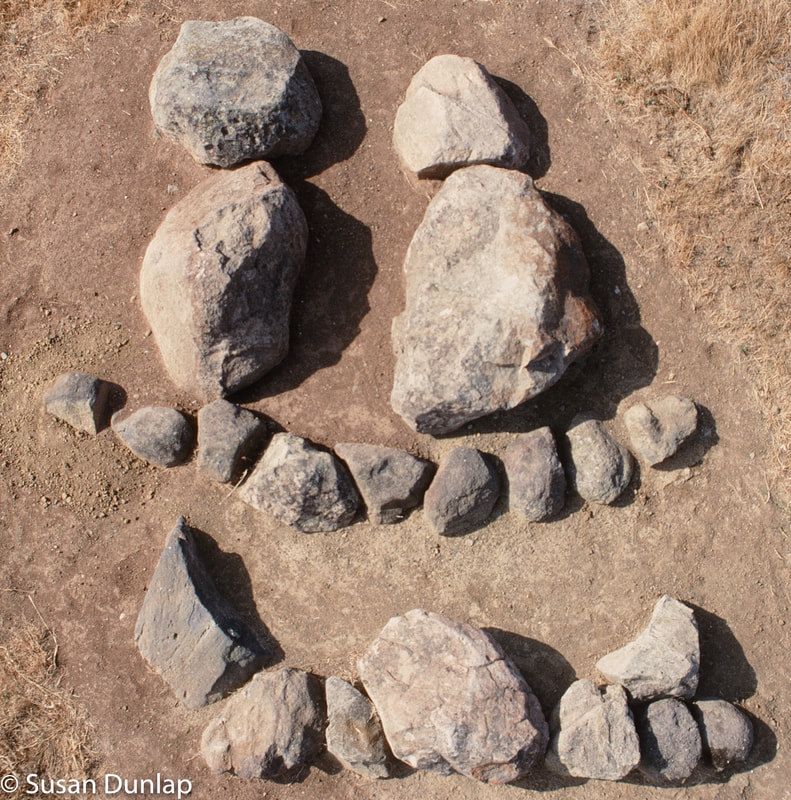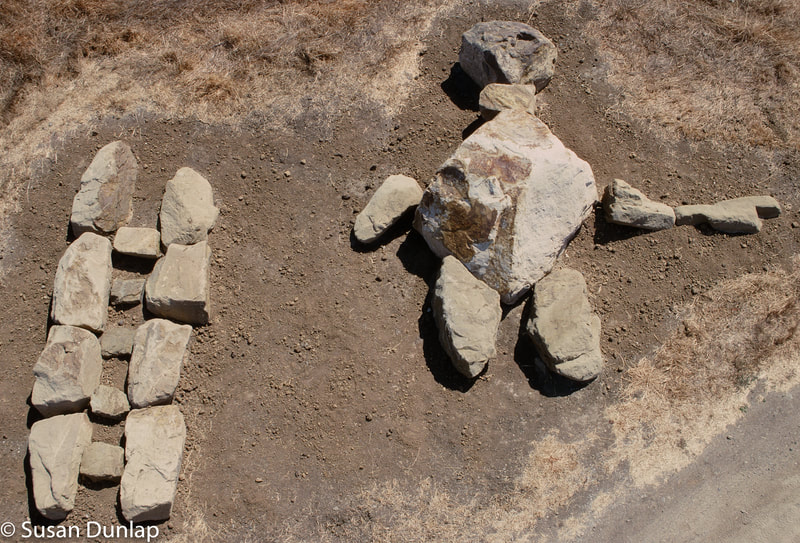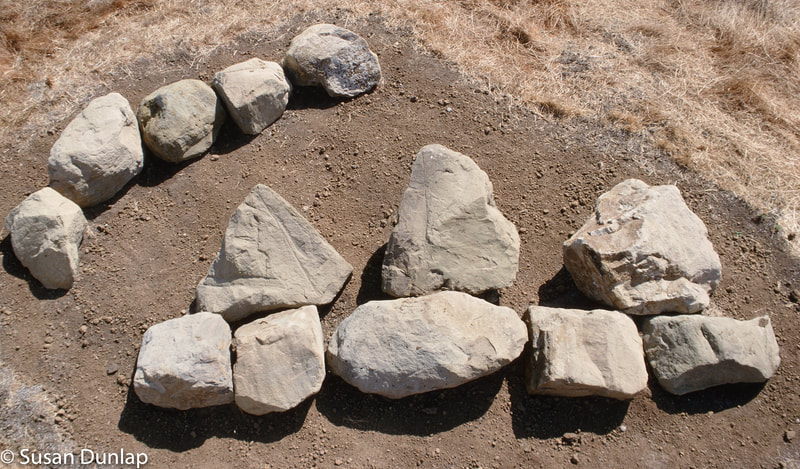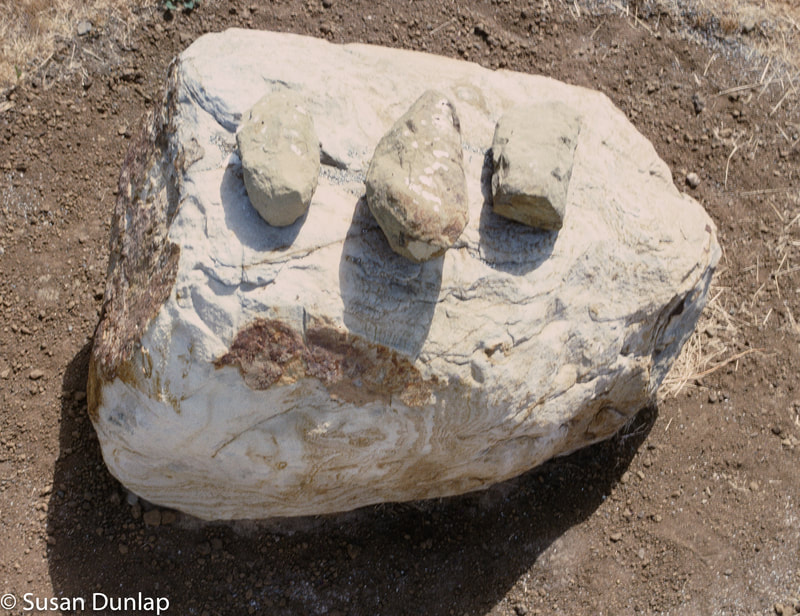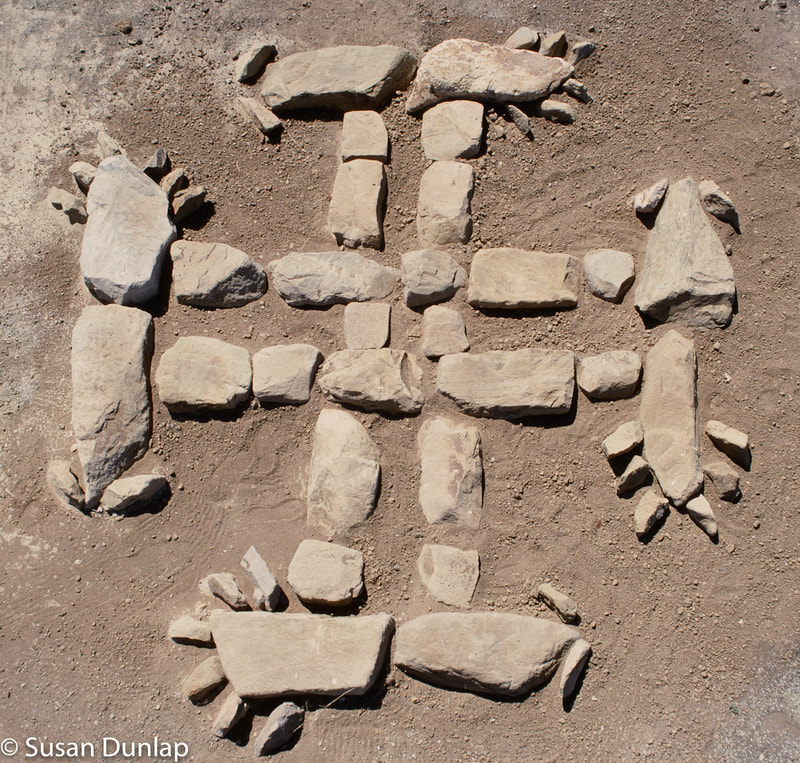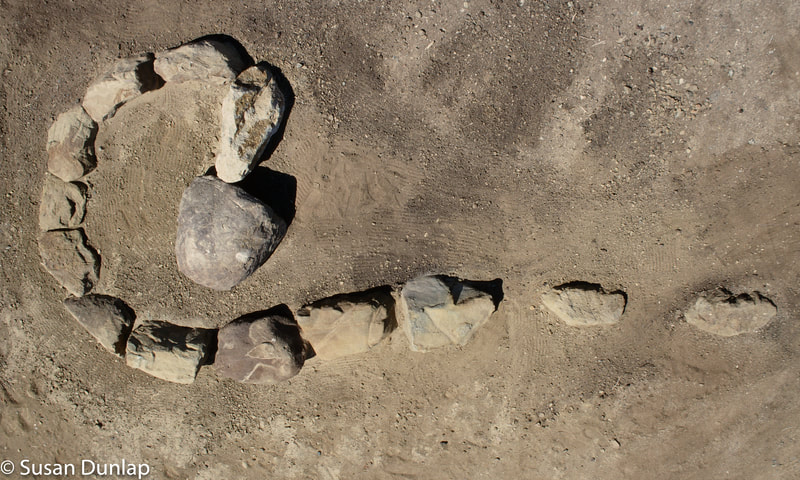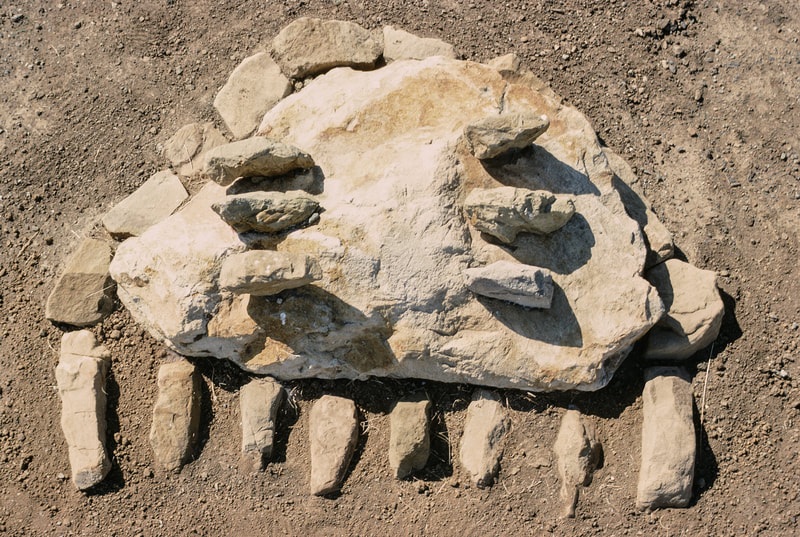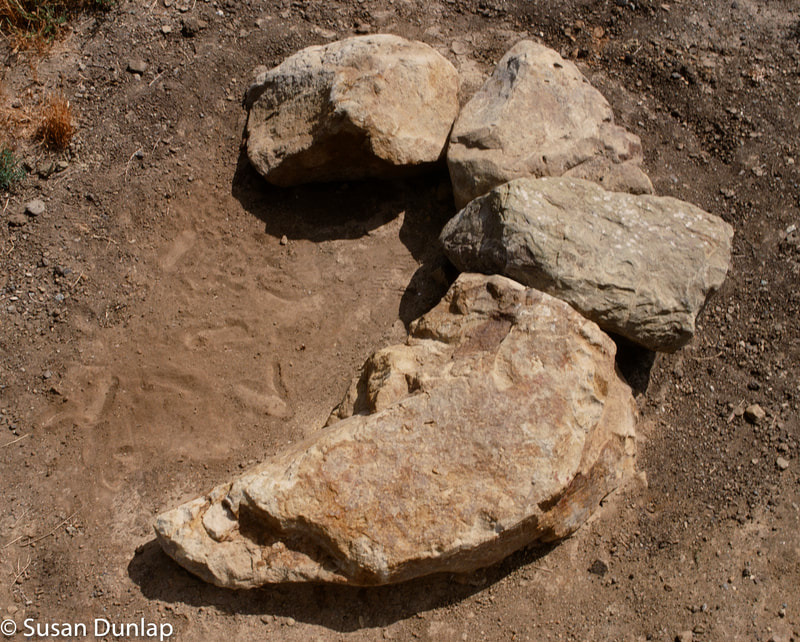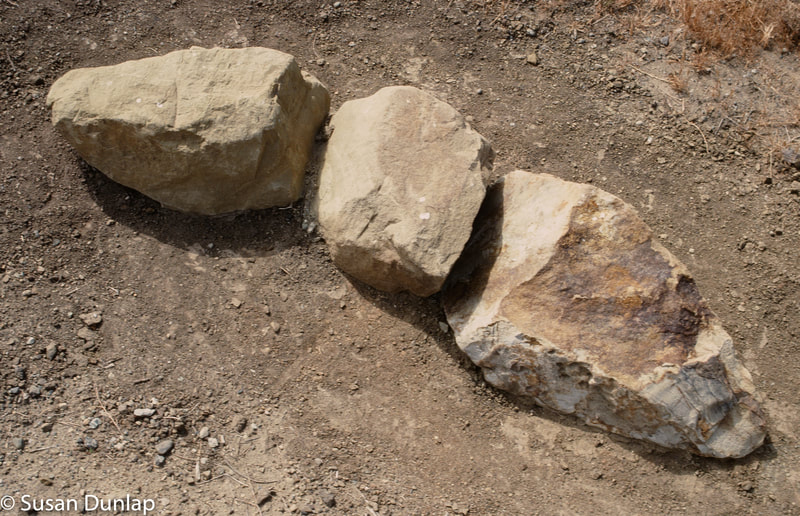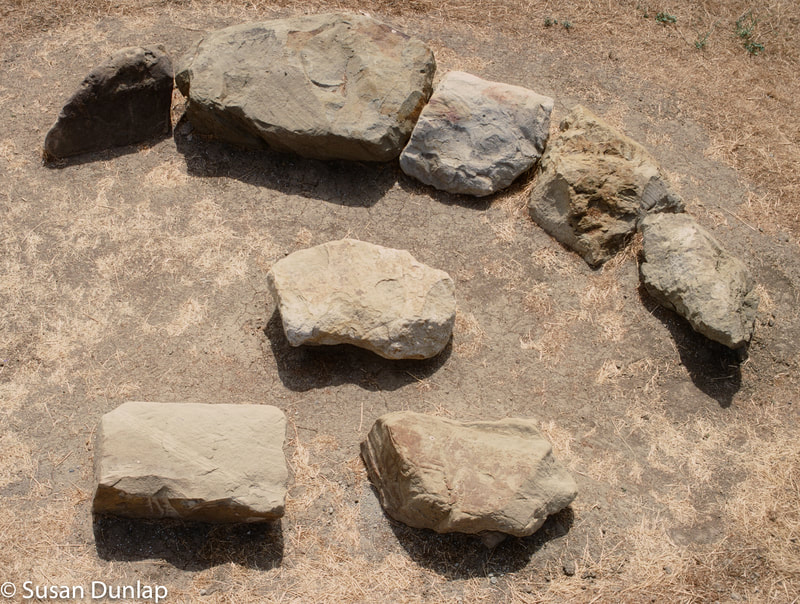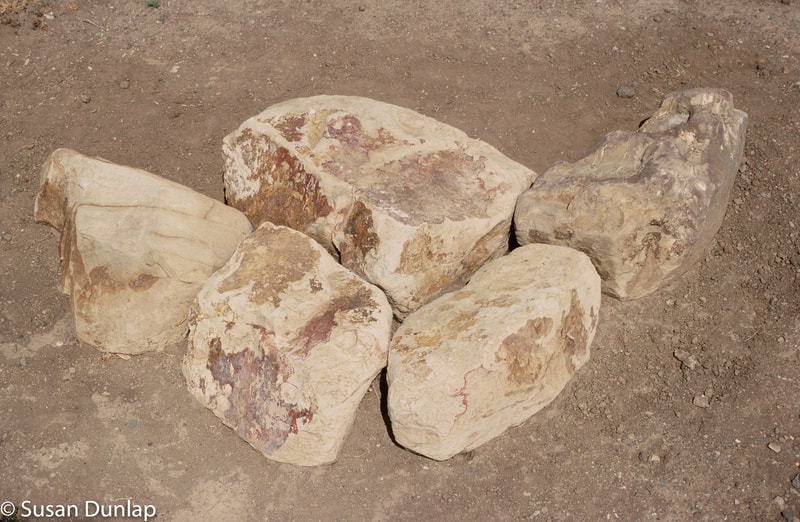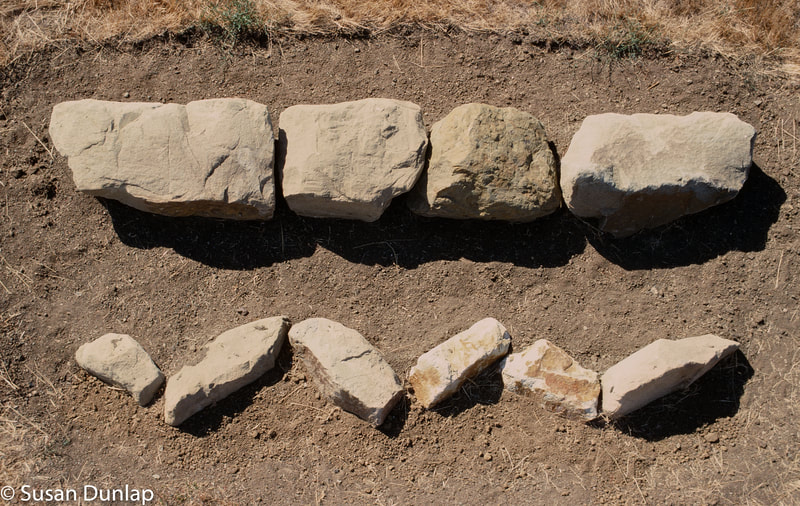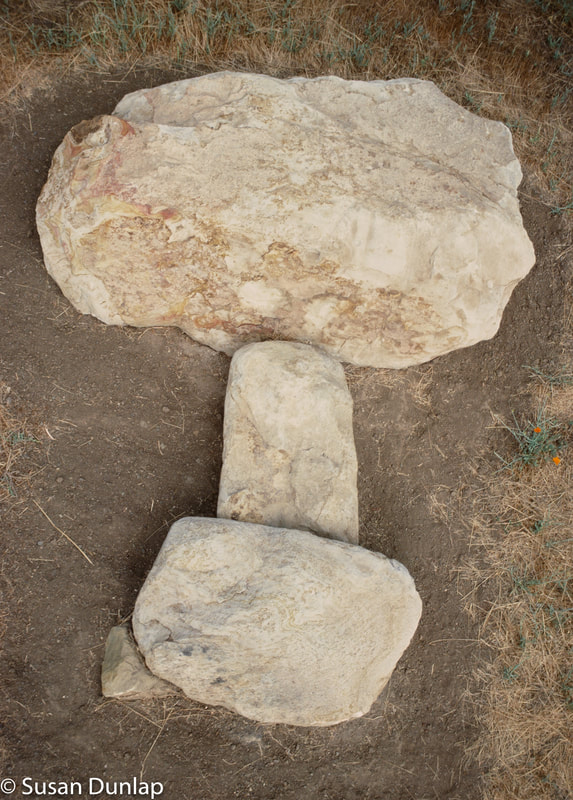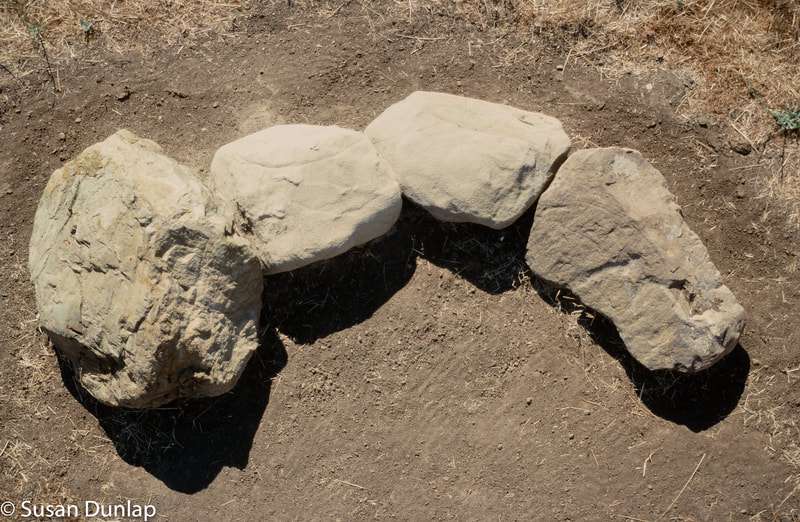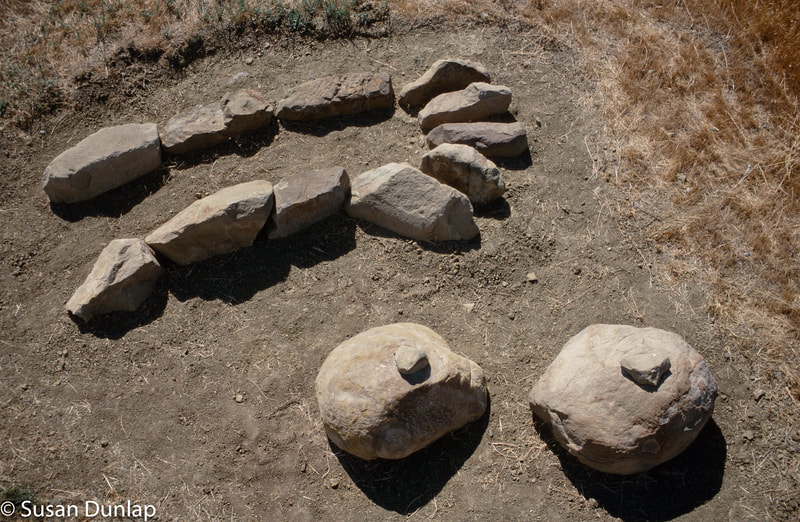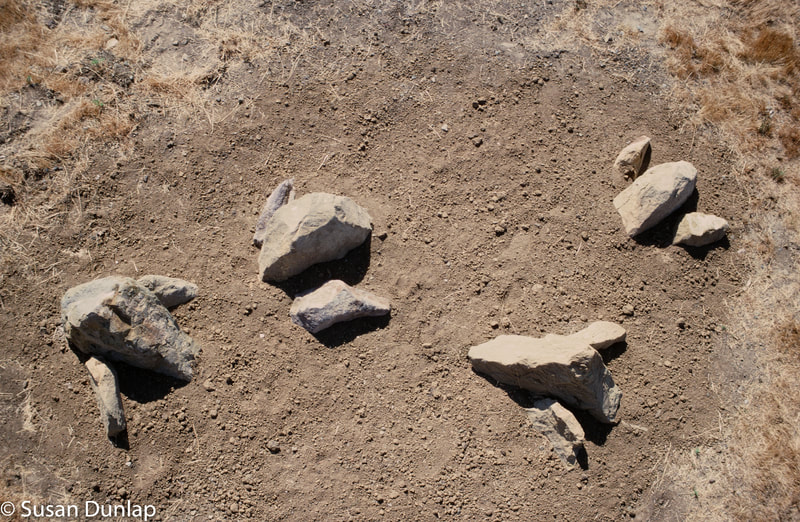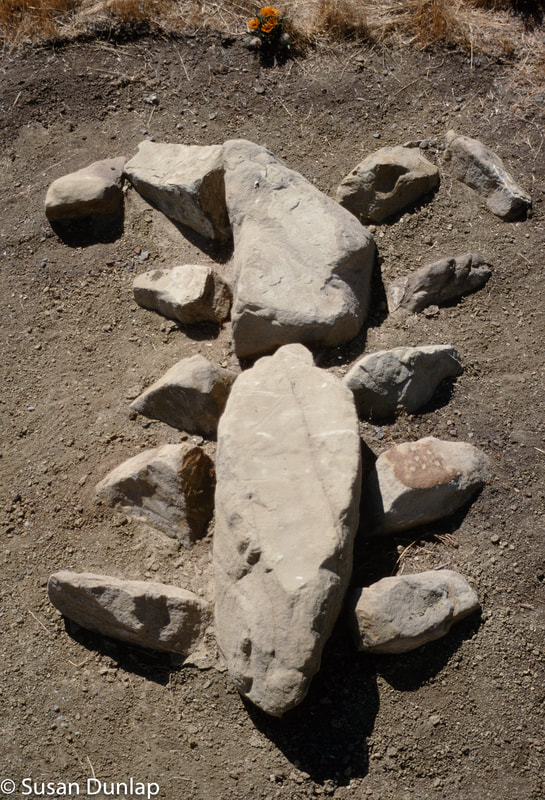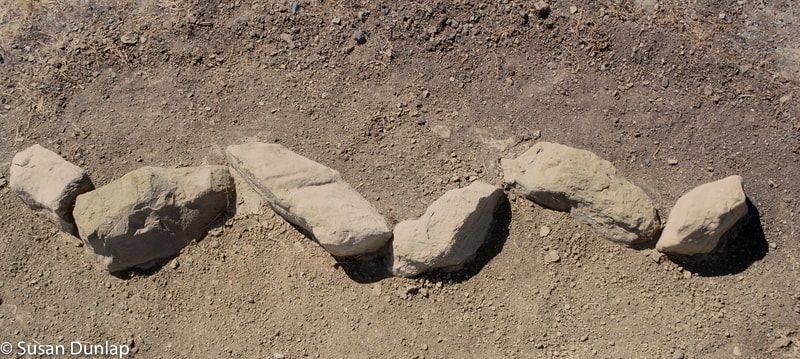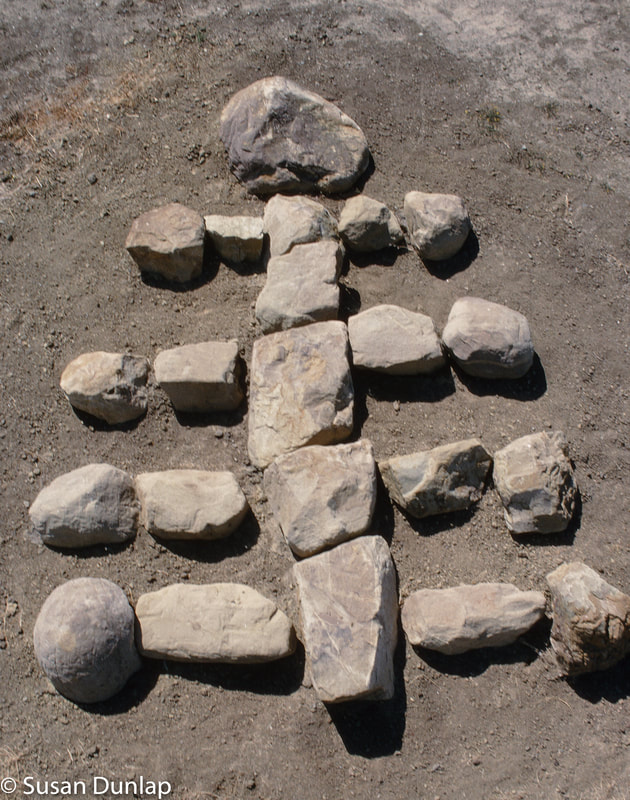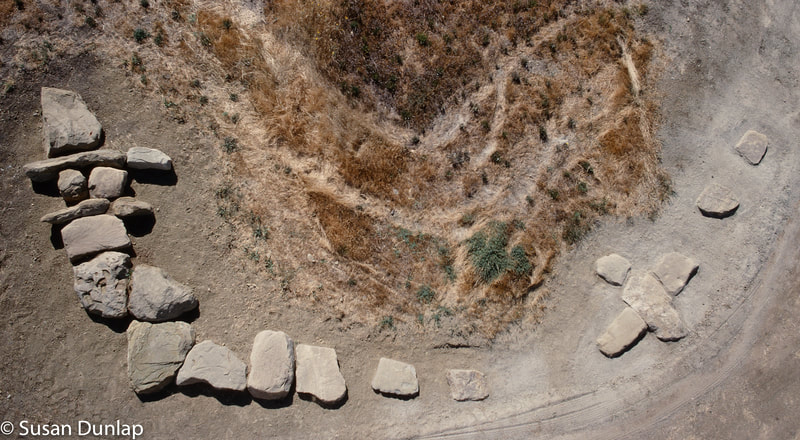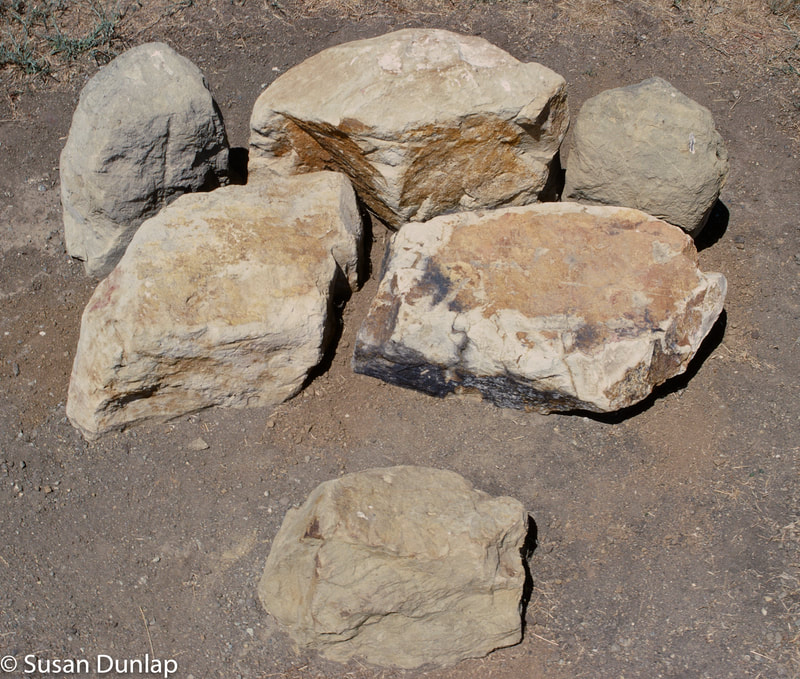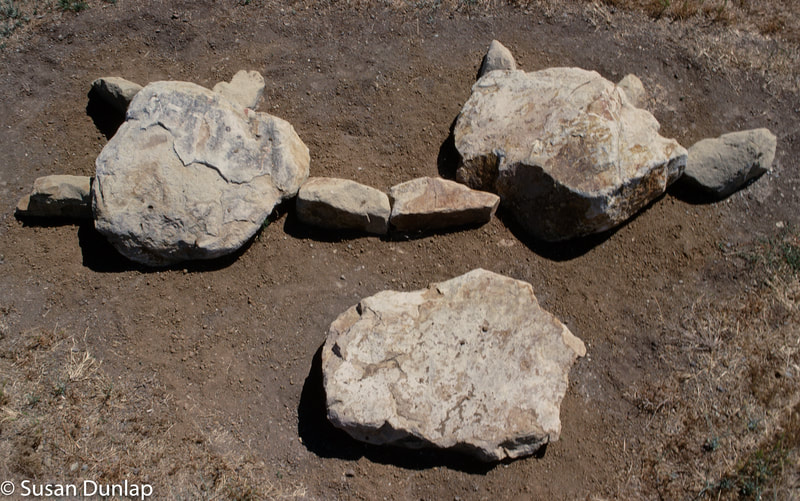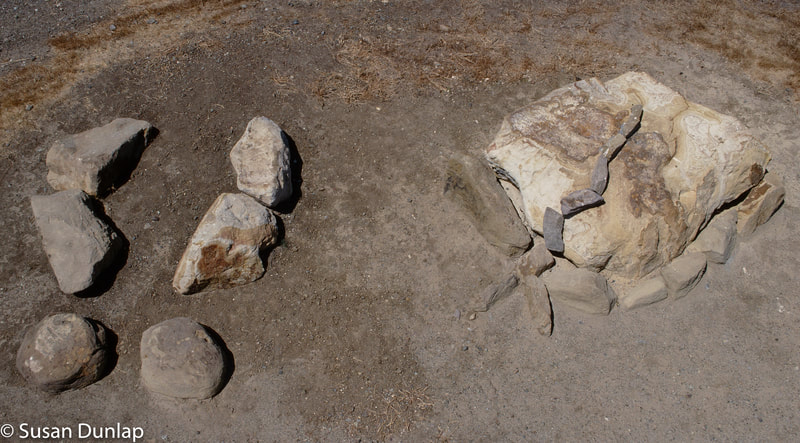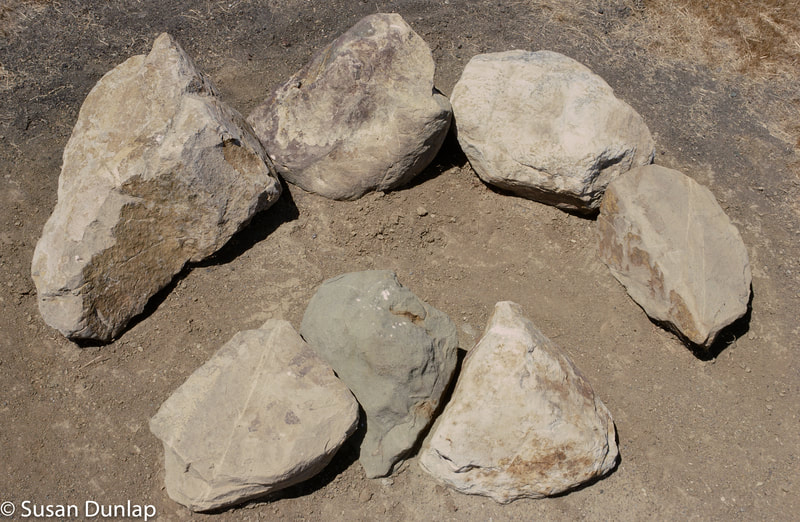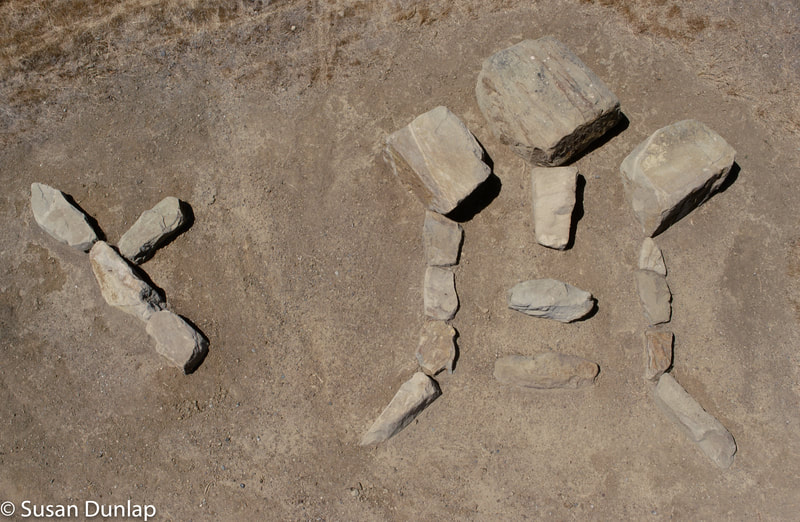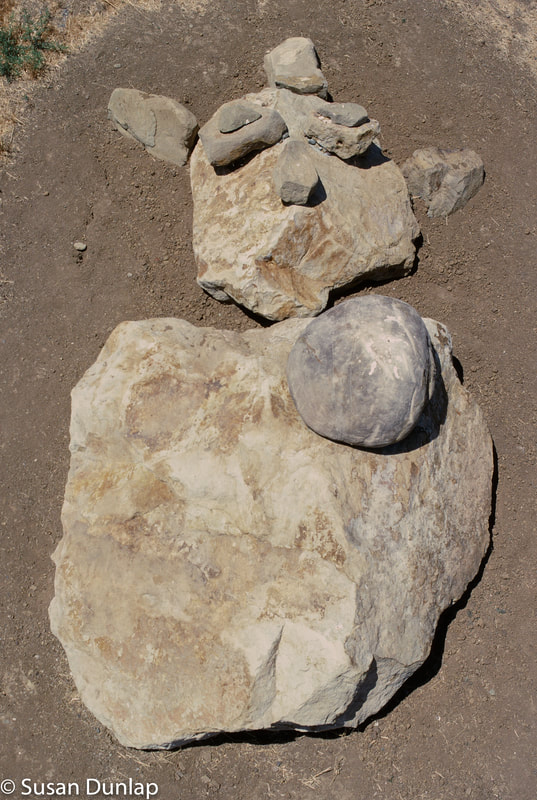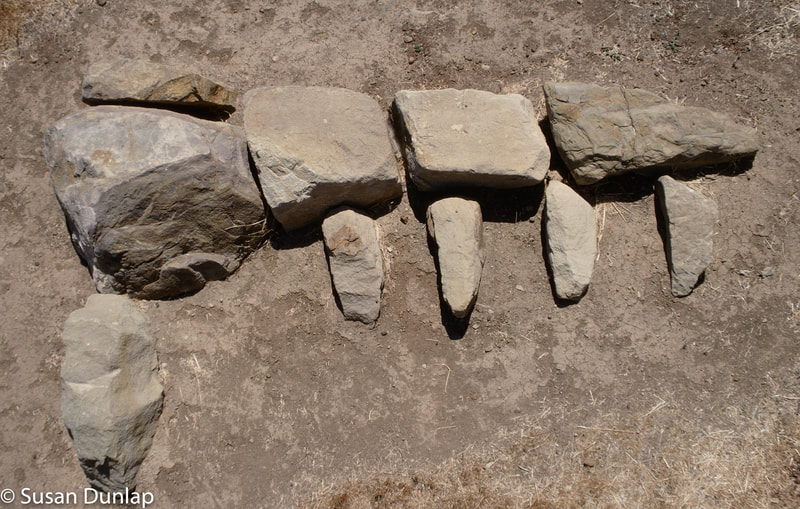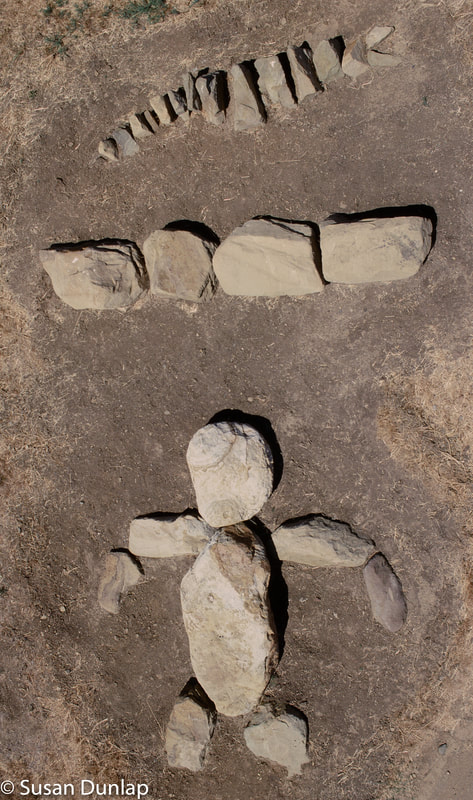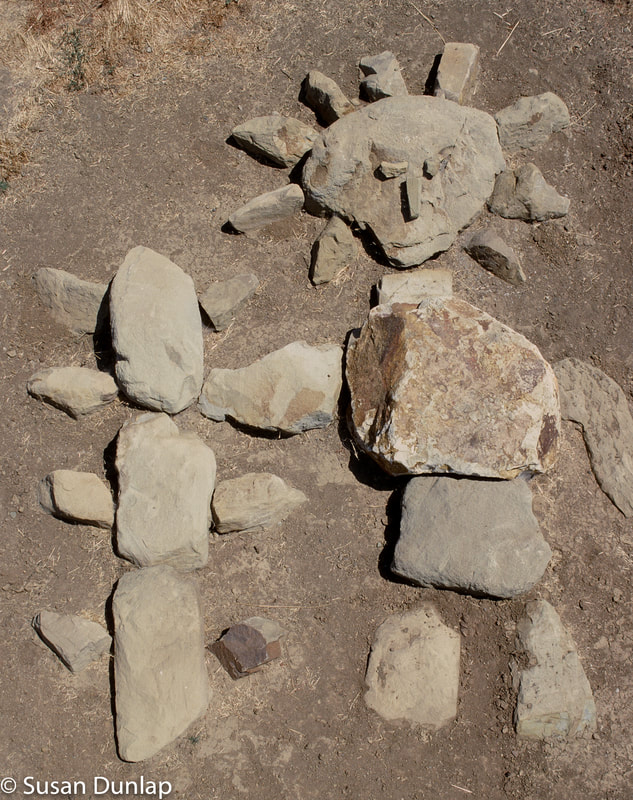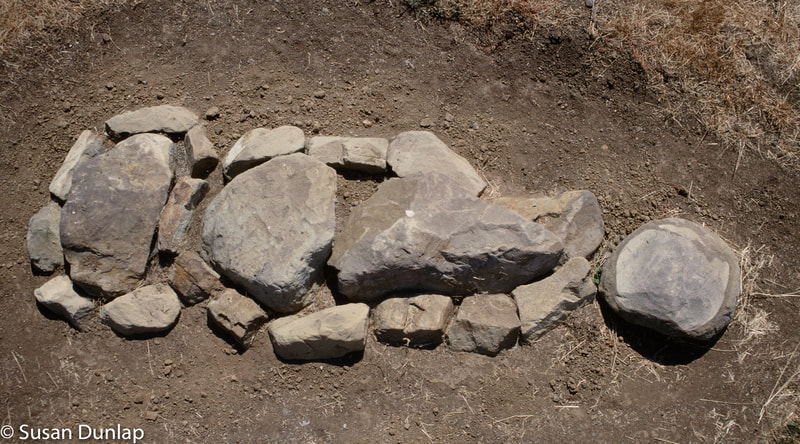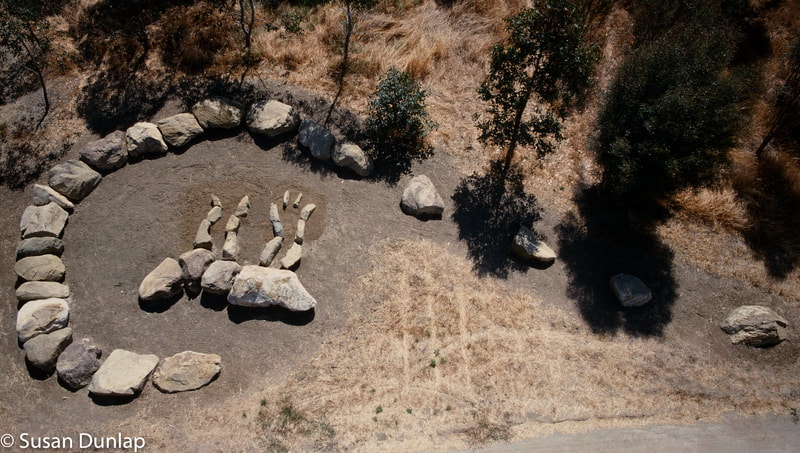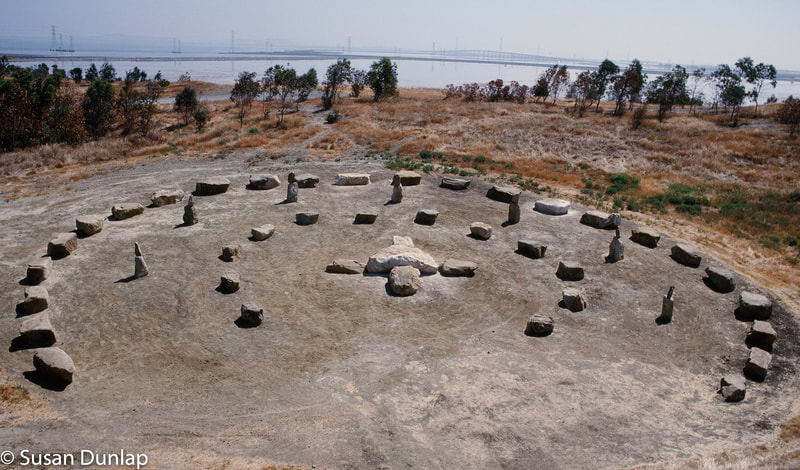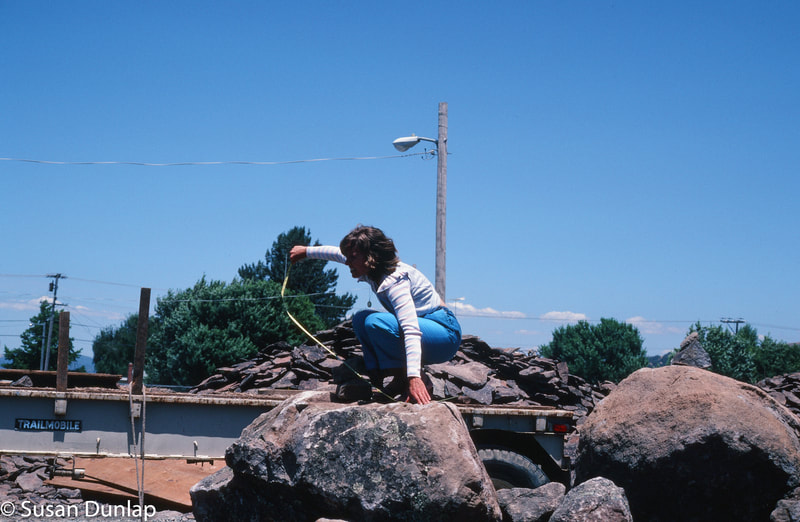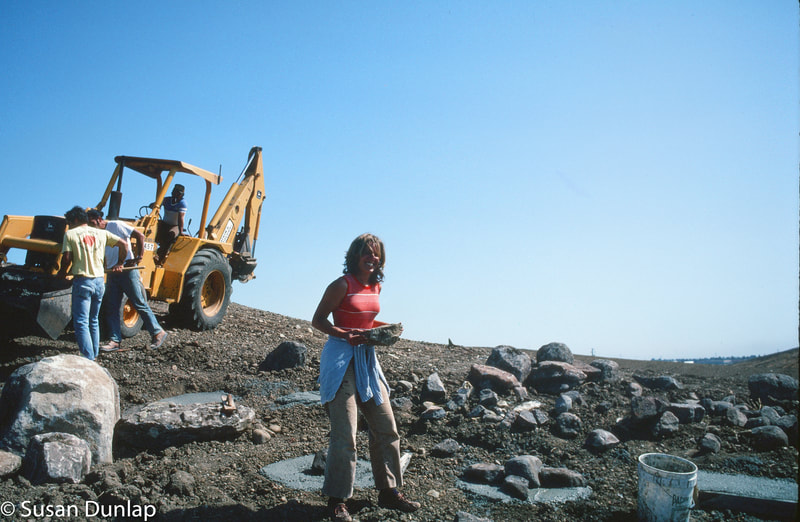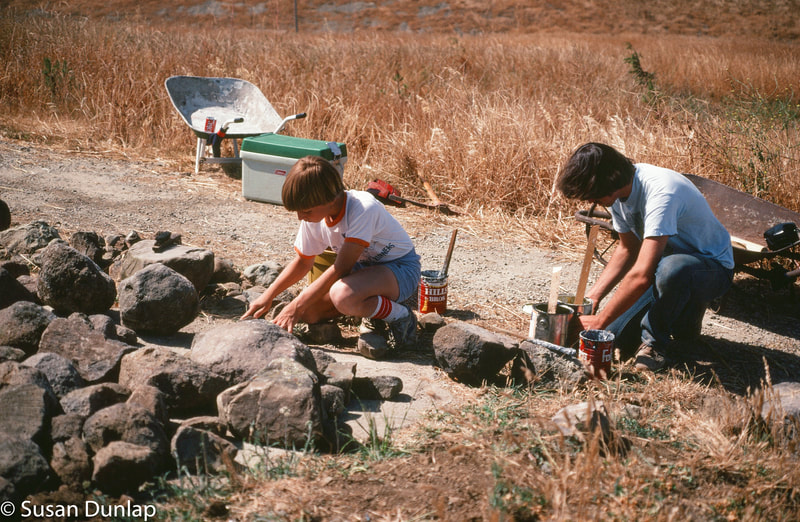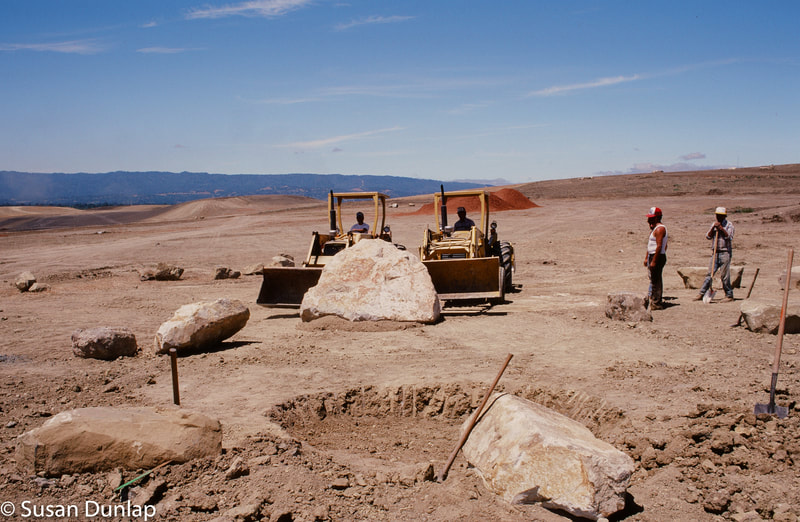The Great Spirit Path
505-ton stone poem inspired by Native American pictographs
created by Susan Dunlap (result: got Christo off my back)
Between 1980 and 1985, the city of Menlo Park, CA commissioned me to create a stone sculpture at Bedwell Bayfront Park. The Great Spirit Path, a 505-ton stone poem spread over a ¾-mile trail in the park, was the result. I used Native American pictographs as a foundation for the sculpture. Many parts of the poem are visible from satellite: Latitude: 37 degrees 29 minutes 33.8 seconds N and Longitude: 122 degrees 10 minutes 13.3 seconds W.
Phase I, comprised of twenty-one pictographs and titled The Evening Good Trail, was constructed during 1980-81. City engineer Lauren Mercer assisted with its development. Major stones, such as those used for “sun,” “earth,” “inspired,” and “many,” were hand selected at a quarry in northern California. All of the field-stones, several tons in all, originated from Sonoma County. A local landscape crew and a boy scout, David Keith, assisted in the installation. David assembled a team of scouts to work on the project and earned his Eagle Scout badge because of his effort.
I expanded the poem when the second segment of the 160 acre site was developed, adding thirty-one pictographs. City manager Mike Bedwell and Lauren were involved in this extension. Phase II was developed during 1984-85. Stones for this Phase originated from a local meadow owned by Stanford University. Stones unearthed during the excavation for the Stanford Linear Accelerator became available to Menlo Park during a restoration of the meadow. Eleven piles of sand stone were delivered to the park and strewn about the large, primary parcel of the park. I drove between these piles, inventoried and measured several hundred stones, and marked each one with a pictograph site number. Often, a bulldozer was used to "stir" the pile so as to expose hidden and obscured stones.
The piece was renamed The Great Spirit Path at this time. Dubbed the “Local Stonehenge” by Janet Wells of the San Jose Mercury News, the stones themselves have survived the elements unscathed.
Daniel Kopisch replaced the original numbered posts that accompanied each stone pictograph in 2010. He too earned an Eagle Scout badge as a result. He used my original photographs and line drawings in the design of the new signage, and worked closely with Elizabeth Lasensky, a volunteer affiliated with the Friends of Bedwell Bayfront Park, to develop and install them.
A complete restoration of the sculpture, trail, signage, and handout is underway. The sun-beaten signs installed in 2010 have been replaced – fifty-three in all – thanks to a coordinated effort between city staff-member Brian Henry and the enthusiastic support of Jim Lewis, a local volunteer.
An EARTH DAY event, staffed by over twenty-five volunteers from Delphix, a Menlo Park software company, occurred in April 2015. They hunted for lost stones and restored over 1,200 feet of paths damaged by erosion or obscured by over-growth. Linda Hubbard Gulker gave this project a nice boost in a write-up at inmenlo. Chris MacIntosh, also affiliated with the Friends of Bedwell Bayfront Park, was a critical connection to make this all happen.
Plans are underway for a complete restoration of the sculpture. Some of the 892 stones used in the artwork need to be re-secured to the substrate installed thirty-nine years ago.
Phase I, comprised of twenty-one pictographs and titled The Evening Good Trail, was constructed during 1980-81. City engineer Lauren Mercer assisted with its development. Major stones, such as those used for “sun,” “earth,” “inspired,” and “many,” were hand selected at a quarry in northern California. All of the field-stones, several tons in all, originated from Sonoma County. A local landscape crew and a boy scout, David Keith, assisted in the installation. David assembled a team of scouts to work on the project and earned his Eagle Scout badge because of his effort.
I expanded the poem when the second segment of the 160 acre site was developed, adding thirty-one pictographs. City manager Mike Bedwell and Lauren were involved in this extension. Phase II was developed during 1984-85. Stones for this Phase originated from a local meadow owned by Stanford University. Stones unearthed during the excavation for the Stanford Linear Accelerator became available to Menlo Park during a restoration of the meadow. Eleven piles of sand stone were delivered to the park and strewn about the large, primary parcel of the park. I drove between these piles, inventoried and measured several hundred stones, and marked each one with a pictograph site number. Often, a bulldozer was used to "stir" the pile so as to expose hidden and obscured stones.
The piece was renamed The Great Spirit Path at this time. Dubbed the “Local Stonehenge” by Janet Wells of the San Jose Mercury News, the stones themselves have survived the elements unscathed.
Daniel Kopisch replaced the original numbered posts that accompanied each stone pictograph in 2010. He too earned an Eagle Scout badge as a result. He used my original photographs and line drawings in the design of the new signage, and worked closely with Elizabeth Lasensky, a volunteer affiliated with the Friends of Bedwell Bayfront Park, to develop and install them.
A complete restoration of the sculpture, trail, signage, and handout is underway. The sun-beaten signs installed in 2010 have been replaced – fifty-three in all – thanks to a coordinated effort between city staff-member Brian Henry and the enthusiastic support of Jim Lewis, a local volunteer.
An EARTH DAY event, staffed by over twenty-five volunteers from Delphix, a Menlo Park software company, occurred in April 2015. They hunted for lost stones and restored over 1,200 feet of paths damaged by erosion or obscured by over-growth. Linda Hubbard Gulker gave this project a nice boost in a write-up at inmenlo. Chris MacIntosh, also affiliated with the Friends of Bedwell Bayfront Park, was a critical connection to make this all happen.
Plans are underway for a complete restoration of the sculpture. Some of the 892 stones used in the artwork need to be re-secured to the substrate installed thirty-nine years ago.
The set of images below are a master set taken when the sculpture was completed in 1985. They are arranged in sequence -- matching the order found along the trail.
The images below, taken between 1980-1985, show the work in progress.
